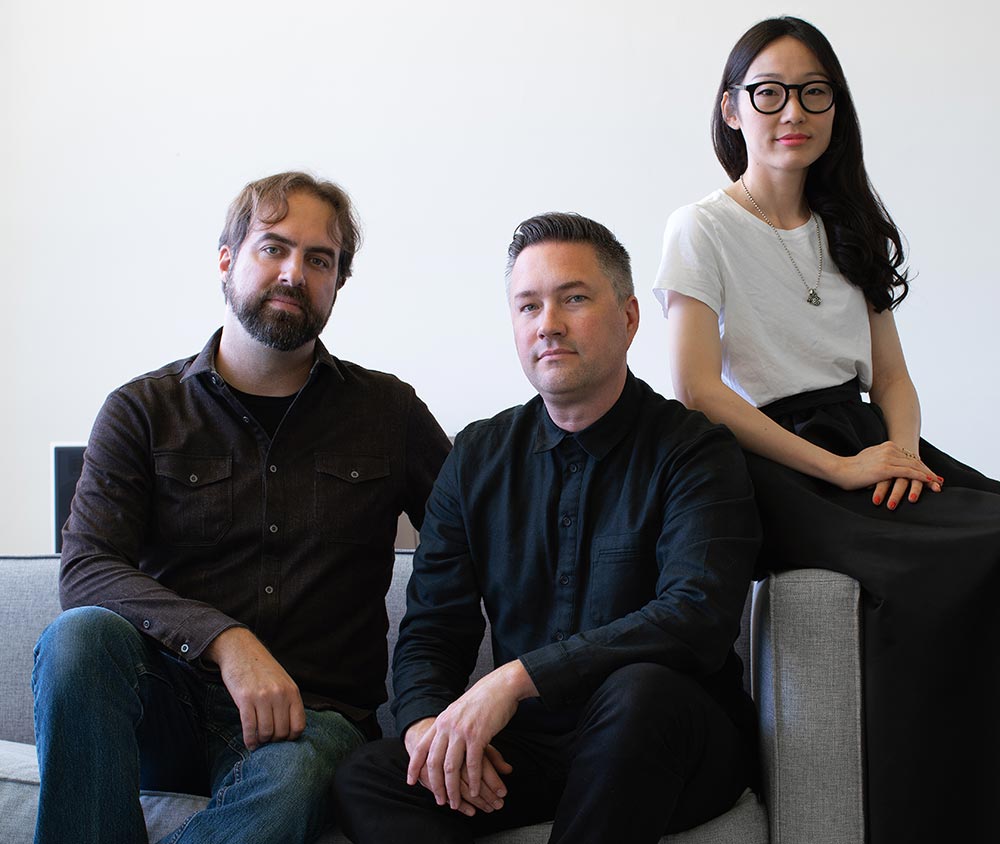The new Meris LVX modular delay pedal is a true milestone for the California company. It is easily the deepest delay pedal on the market with the ability to customize so many parameters that you can create a signature tone in minutes. It’s complex, intricate, sophisticated and just fascinating, if you are willing to take the time to get under the hood and experiment with everything it offers.
Considering the breadth and abilities of the LVX, we had three different reviewers spend a month each with the pedal to provide a balanced and objective review. Our reviewers consisted of a guitarist, a keyboardist and a sound designer. Even though each one came to the LVX with a different perspective, they all came away impressed. We included their remarks in quotes below.

For a limited time only! Up to 80% off all Waves Bundles. PLUS click the banner above or the Go button for an additional 10%! This is Waves best deal yet! Get yours today before this special ends! Go!
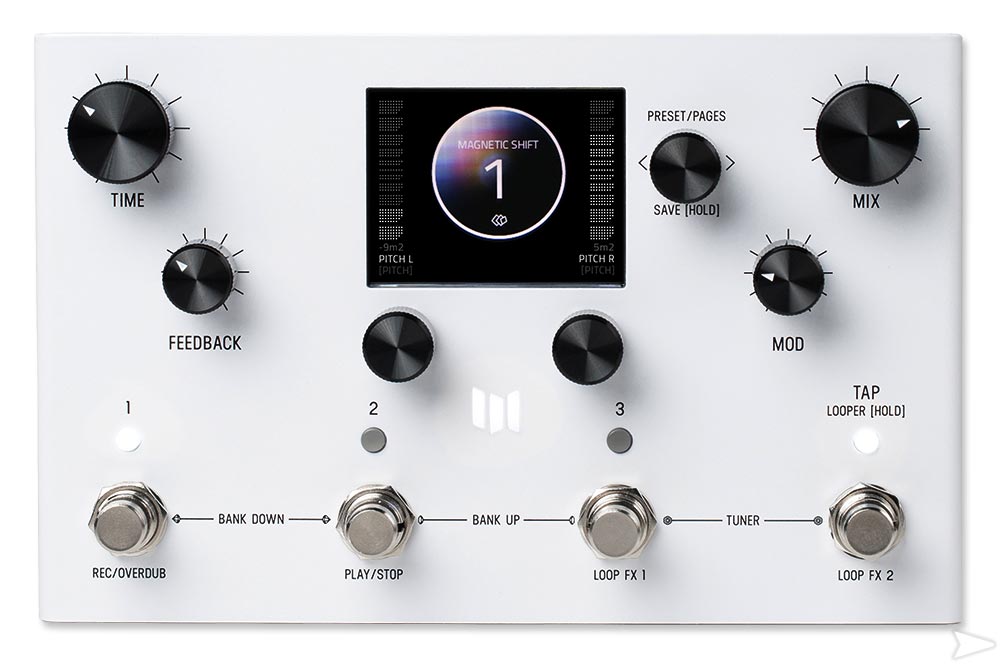
This is “clearly not your Dad’s delay pedal…”
The form factor says guitar pedal, but with true stereo and MIDI I/O, this is “clearly not your Dad’s delay pedal.” In fact, it’s the first Meris pedal with a screen interface, which can be viewed in two flavors Graphic or Text-based. There are seven knobs and four foot switches on the elegant white chassis, and a glowing Meris logo. The back consists of two stereo inputs, two stereo outputs, an expression pedal input, DIN-based MIDI input/output, USB-C and a 9v DC power inputs. For non-guitarists, who are unaware of the industry’s petulant for not including a power supply, you’ll have to source your own.
For guitarists who are daunted by more than three knobs on their pedal, this effects processor is definitely not for you. The amount of complaining that guitar manufacturers have to endure from guitarists who can’t deal with a Shift key, a toggle switch, a sub-menu or heaven-forbid, dip-switches, is at an all time high, but don’t blame the manufacturers. With boutique guitar pedal manufacturers certainly having a moment in the industry by pushing the envelope of what’s sonically possible, the market certainly doesn’t need another Boss OD-3 rehash – users now demand innovation. This is what has brought us exciting new products from Eventide, Chase Bliss and Hologram, who delivered the Microcosm. The Microcosm won a FutureMusic Power Award and was named Gear Of The Year in the effects processor category – the first time a guitar pedal won. Meris knew they had to deliver something big, something noteworthy and something that would define the company going forward.
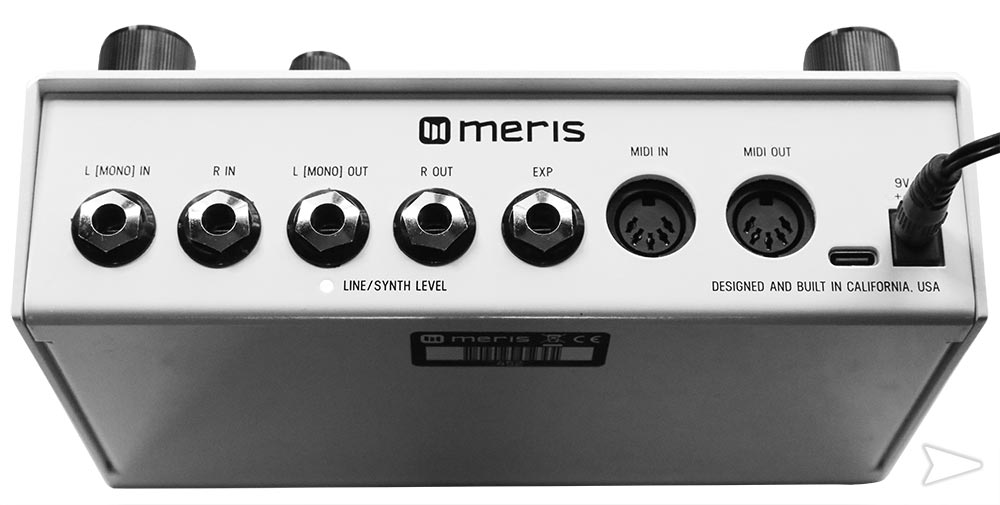
Meris was launched by Terry Burton, Jinna Kim and Angelo Mazzocco at then end of 2013. Each one of the founders came to Meris with a distinct set of skills that perfectly complemented the others. Their unique backgrounds also allowed them to hit the ground running with quality products that got the attention of musicians worldwide. “My entry into the world of music gear was begging for a job from the local gear repair shop owner Pat Buley,” states Terry Burton. “I was only 16 and there was no job opening but he still said yes. His training had a huge influence on me and that, along with independent study and engineering schooling, enabled me to get a job at Line 6 later on. Working as a repair tech as a teen exposed me to all types of gear from guitar amps to synths to power amps and mixers, etc. What was really valuable was that I got to see how everything failed in the field. Because of that experience, once I became a design engineer I was hyper aware of those pitfalls. Later on, after designing a number of products for Line 6, I couldn’t shake the idea that I wanted to start something of my own, so I did, and the Strymon brand was born. After about five years it was again time to start something new. Now at Meris, I’m the happiest I’ve ever been.”
If you learn engineering you can use it to build anything…
“Getting my first electric guitar as a surprise from my Dad was a very pivotal moment,” recalls Angelo Mazzocco. “My father also told me that ‘if you learn engineering you can use it to build anything.’ Hearing that as a teenager, I was sold, and completely convinced that I was going to find a way to make instruments. The next thing you know, I was at the University of Michigan studying Electrical Engineering and focusing on DSP. After college, I was lucky enough to land a job at Line 6, where I learned an incredible amount from the talented founders and engineers who worked there. It was a phenomenal learning experience that I am really grateful for.” Terry also confirms that working at Line 6 allowed him to blossom as a designer. “Line 6 was really my foundational training in engineering. That’s the place where I learned how to turn ideas into actual working, manufacturable products. Our mentors there were so generous with sharing their knowledge.”

The LVX is the culmination of Meris’ achievements to date and positions them for exciting new possibilities for the future…
Creative Director Jinna Kim, who is also Terry Burton’s wife, worked with Terry on the aesthetic and industrial design of all the Strymon pedals up to the Big Sky. Although largely uncredited at Strymon, it gave her the experience to provide Meris with a sophisticated presence from the onset. Kim’s design experience started in 2000 at Lynda .com when she was only 21 years-old. “I worked my way up to become the Video Editing Manager. And that changed the course of my career. After Lynda, I worked for visual effect houses or high-end design companies all over Los Angeles, California. I worked alongside the best of the best in the design field and I’ve had great mentors along the way. Of the many things I learned along the way was never to compromise on quality, as well as a serious work ethic.”
All this experience, as well as the latest technology, has allowed Meris to make LVX one of the most deepest and most configurable guitar pedals you’ll find. To be upfront, it would take thousands of words to go through everything that the LVX can do, so we’ll do our best to spotlight the highlights and showcase this pedals mojo. However, one of our reviewers said it best, “just imagine if The Edge (of U2 fame) had this pedal when he was developing his signature delay sound…wow.”

Meris calls the LVX a “modular delay system” due to the many different ways to shape, sculpt and craft your delay with blocks of attributes – far beyond what even world-class companies have achieved with rack units. If you think you can determine what the LVX can achieve based on the included presets, think again. They’re intriguing, but “they just scratch the surface of the potential of the LVX.”
“The LVX has the power to realize your delay dreams…”
Starting with the latest ARM processor, “the LVX has the power to realize your delay dreams” with the ability to configure every single detail and then employ the built-in sequencer, the expression pedal and/or MIDI to tweak all that action on the fly. You can use Kim’s “Bubble” graphical interface, which seems to be targeted towards guitarists, or just go with the Text-based paradigm to access more detail. Our keyboardist and sound designer gravitated towards the Text interface, while our guitarist went for the Bubbles. “I really liked the simplicity of the Bubble metaphor, but I think there will definitely be some haters out there.”
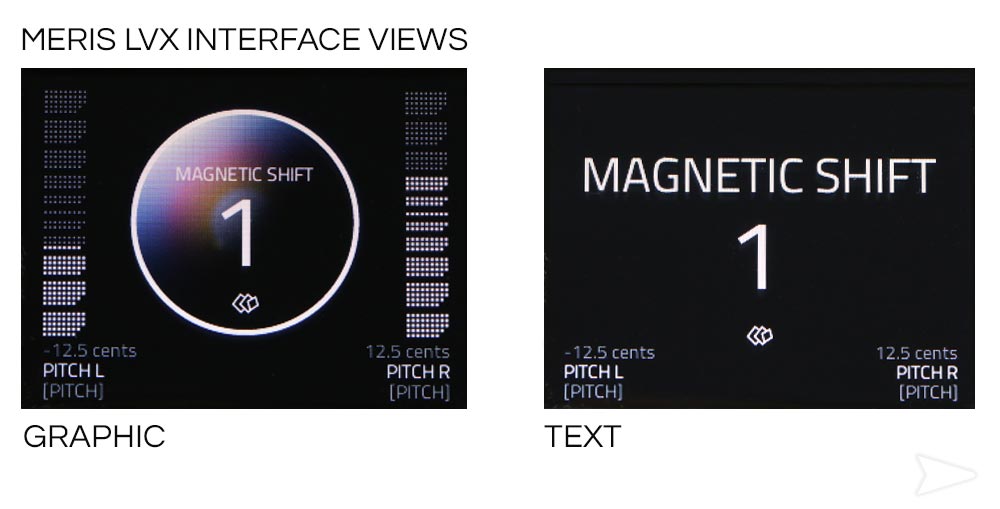
Looking at the top of the unit, you have four main knobs, Time, Feedback, Mix and Mod. There are three push and turn stepped knobs surrounding the 2″ x 1.5″ color screen, which change functionality based on the page. When you turn on the LVX, you’re treated to the last loaded preset you had on before you turned it off. The bottom two custom encoders under the screen, which Meris calls C1 and C2, showcase the Delay’s Structure, Poly, Reverse, Series, Standard, Multitap or Multfilter and the Delay Type, Magnetic (Tape), Digital or BBD (Bucket Brigade Delay). The push and turn encoder to the right of the screen (C3) allows you to navigate to the individual parameters via the graphical orbiting Bubbles, or change to the text view, which allows you to tweak six different settings at once. To change, you have to navigate to the Globals page, then Edit Page, then switch from Graphic to Text.
Meris LVX Specifications:
- True Stereo Processing — 2540mS of Configurable Dual Delay
- Premium analog signal path and 24-bit AD/DA w/32 bit floating point DSP
- Advanced ARM Processor
- Digitally controlled Analog mix bus
- Stereo input and output
- MIDI In/Out via Din Jacks
- MIDI beat clock synchronization
- Includes processing algorithms from the Meris Polymoon, Hedra, Enzo, and Ottobit Jr.
- Selectable Note Divisions for each side of the stereo Dual Delay
- Switchable input/output headroom level for Instrument or Synthesizer / Line levels
- Assignable Expression Pedal control on dedicated jack for multiple parameters simultaneously
- Analog Devices JFET input section
- 99 Preset Locations in 33 Banks
- Favorite Preset Bank for instant access to your 3 favorite presets
- Instant Access Tuner with configurable Reference and Output mode
- True Stereo 60 Second Looper
- Conversion 24 bit A/D and D/A — DSP 32 bit floating point
- Sample Rate 48000 Hz
- SNR 115 dB Typical
- Frequency Response 20Hz-20kHz
- Bypass Selectable True Bypass (Relay) or Analog Buffered Bypass
- Dimensions: 7.25″ length / 4.5″ width / 2″ height — Weight: 24 ounces
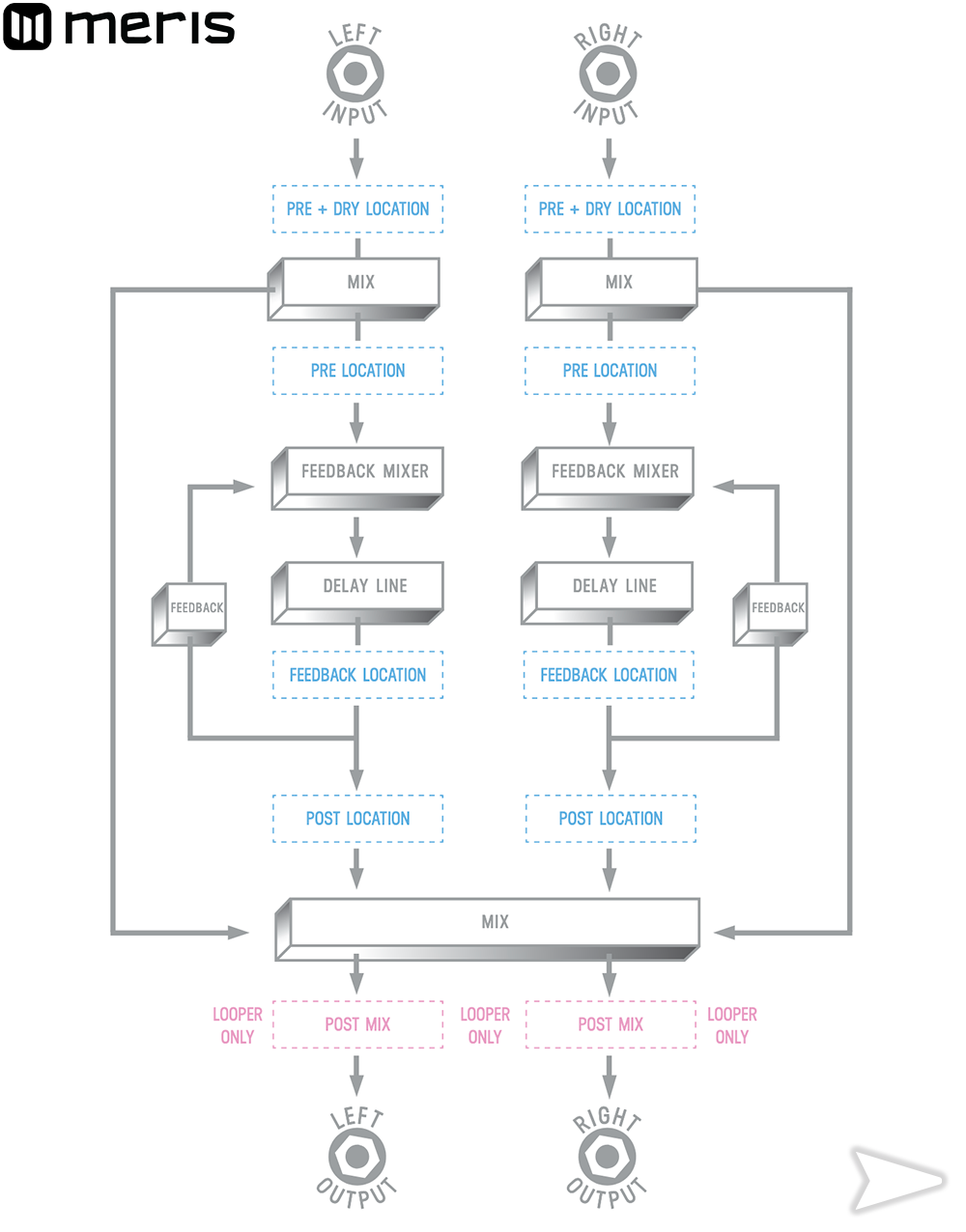
On the main preset page, clicking C3 will put you into Edit mode. Here you can select different categories and change parameters within the gleaming Bubble in the upper left corner. Want to make changes to another category? Simple, just rotate the C1 knob to the category you want to tweak and then use C2 to change the value. Use the C3 to navigate to the Tactile page so you can modify the Time, Feedback, Mod and/or Mix value at any time while editing the preset. Globals, with its defining Gold sheen, allows you to change more basic settings such as MIDI, Brightness, Input level, the Tuner reference, Tactile view and so much more.
You can assign two parameters of your choice on the left and right sides of the preset bubble that you want immediate access to via the C1 and C2 knobs. The visual L/R indication is a filled-in dot that can be witnessed on the parameter in the Edit page. Unfortunately, it can’t actually be assigned here – it’s just a notification of assignment. What’s even more complicated is that there are two methodologies for customizing these main page parameters based whether you’re in Graphic or Text Edit mode. A filled in left dot indicates that parameter will appear on the left side of the preset page, and a filled in right dot denotes the parameter will appear on the right side. This visual metaphor caused additional confusion with two of our reviewers who thought this illustrated a secondary page within that attribute, a typical use of this type of mental model. The other visual design element that was spotlighted was the preset modification indicator, which looks like three spread out playing cards on the main preset page. The only way to comprehend what the “cards” indicate was by going to the manual. Meris could have simply used an asterisk after to the preset’s large number, a well known allegory, and used this real estate for something more useful.

The LVX has true stereo processing and allows the user to modify the left and right channels independently. This ability provides enormous power to sophisticated users and sound designers to create something truly “unique and magical.” However, and this cannot be stated strongly enough, this only works if the sound quality is of the highest caliber. Here, Meris delivers “big time.” The LVX “hits the unicorn mark” by “being clean without being sterile” and contains “a sweet softness and warmth that you rarely encounter in digital delays.” It’s this incredible sound quality that allows musicians to take full advantage of what the LVX’s true stereo processing is capable of without “quickly getting muddy,” “overly chaotic” or “downright cacophonous.” Even if you force the LVX into disorderly realms, it still never sounds swampy or grubby, maintaining definition no matter “how mental you get.”

The easiest way for electronic musicians to get their music onto Spotify, Apple Music, iTunes, Amazon Music, Tidal, Instagram, Facebook, TikTok, Pandora, Twitch & much more! Click the banner above or the Go Button to save 7% off of your signup! Go!
“Incredibly deep…”
The LVX’s modifier section is “incredibly deep” and this is where things “can get psychedelic, fast.” With independent processing of the channels and the stellar sound quality mentioned above, the only real limitation is how much patience you have to explore all the possibilities, and there are many! The modifiers allow you to automate the attributes “giving symbiotic life to elements to create evolving soundscapes that live far beyond your first pick or strum.” A modifier can be Sample & Hold, a 16-step Sequencer, two independent LFO’s and a triggered Envelope Generator.
The Sample & Hold can randomly change a parameter at a fixed interval based on speed and note division. The Sequencer’s 16 steps are of equal length, but you can change that by turning the minimum value down to zero, which means skip. This is important to know because if you want the step to “rest” then only turn it down to 1, or else the sequence gets truncated. Every time the sequence cycles, set by the speed or note division, a new element is generated. The envelope generator is “well thought out” and provides for Attack/Decay times and Shape (clipped attack, linear or exponential). The two LFO’s, A and B, are more complex with nine different shapes: 3 Steps Up, 3 Steps Down, Four Steps Up, Four Steps Down, Triangle, Sine, Square, Ramp Up and Ramp Down.


The LFO’s, Envelope and Sample & Hold modifiers all have Minimum and Maximum values, which can have a substantial effect on how each modifier performs its duties. For example, reversing the Minimum and Maximum values in the Envelope modifier can invert the envelope’s shape. Another example would be using the Min/Max values to change the filter’s 20 – 15000 Hz frequency range. Want to fit the frequency range into a particular “pocket,” increase the minimum and decrease the maximum values. Experimenting with the Min/Max values can also lead to interesting variations with Sample & Hold.
The LVX’s processing elements incorporate action from some of Meris’ pervious releases, including bit-crushing from Ottobit Junior, filtering from the Enzo, pitch shifting from the Hedra, flanging/phasing from the PolyMoon and a lot more. In fact, the LVX is more like a culmination of everything Meris has done to date in a delay format. Let’s take a look at what a musician has at their fingertips.
In the preamp category, you can select between Tube (mid emphasis), Transistor (high boost), Op-Amp (Low cut with broadband boost), Drive (slight edge), Bit Crusher (adopted from the Ottobit for Chiptune crunch) and Volume Pedal. For the Filter, your choices are State Variable Filter, Ladder Filter, Comb Filter and Parametric. Both the State Variable Filter and the Ladder Filter are derived from the Enzo and can be tweaked via their Spread, Topology, Frequency and Resonance attributes. Our keyboardist found the Comb Filter added a distinctive flavor to many of his favorite patches. The Parametric filter is a single band shelving equalizer that works best at the end of the signal chain.
The Hedra’s algorithms show up in the LVX’s pitch category, including Harmony, a two-voice diatonic, Micro Tune, true stereo and Mono Chroma, a favorite of our guitarist and keyboardist for “stinging leads.” There’s also Poly Chroma, a stereo summing polyphonic chromatic pitch shifter from Special Guest Star John Reeves, which works quite well on chords. Last, but not least, is Lo-Fi, a pitch shifter liberated from the Ottobit Junior.

The PolyMoon has its fingerprints all over the Flanger, Barberpole and Chorus taking full advantage of Meris’ early work. The Chorus is true stereo and can go full Vibrato when dialed up to max. The Flanger is “reserved and more laid back than others on the market” – a good thing – while the Dynamic Flanger employs an envelope to creatively elevate the proceedings. Barberpole makes “great use of the stereo spectrum to spread the cascading mandalas into the abyss.”
The other three, Granulize, Ring Mod and Cassette fall into the audio degrade realm with varied results. Ring Mod provides metallic flavor and the Granulize mutates the incoming sign with buzzy, jittery digital artifacts. Our reviewers found Cassette to be the weak link. Considering all the recent processor releases that have emerged on the market that create wonderfully inebriated environments that sound like everything is about to go off the rails, our reviewers didn’t think Cassette “did enough.”
What you can do with an Expression Pedal is “mind boggling.”
What you can do with an Expression Pedal is “mind boggling.” The LVX allow the user to make six different pedal assignments and for each one of those assignments you can select the parameter that the expression pedal is controlling. Let that just sink in. The Expression modifications are only active when an expression pedal is connected, otherwise the LVX will not recognize them. You can also control the expression pedal range with MIDI control change messages. The LVX also has a built in Tuner that is activated by pressing the number 3 and Tap footswitches simultaneously, “a nice value-add.” Finally, the Meris LVX contains a 60 second stereo looper, which follows the same traditional format as other guitar pedals.
As you can see, for a guitar pedal, the Meris LVX has a lot going on for users who are willing to “get their hands dirty.” Our guitarist, who adores pedals that think out of the box, felt that the LVX can provide “a superior delay solution” for more conventional guitarists, as well as “super users to explore new unknown worlds.” Our synthesist found that “the LVX provided special opportunities for keyboardists to craft their own unique sounds.” In fact, with the extra time he had with the LVX, he explored running mono outputs from two different synths into the stereo inputs of the LVX. “The LVX glued the sounds together to create a bespoke patch that sounded simply amazing.” Finally, our sound designer labeled the LVX as “one of the best delay pedals I’ve ever used.”
Conclusion
The LVX is the culmination of Meris’ achievements to date and positions them for exciting new possibilities for the future. The sound quality is absolutely stellar with an expansive soundstage that takes complete advantage of the true stereo processing. While the meek can simply utilize the presets and Kim’s Bubble interface for satisfying results, those who are willing to explore the inner depths of the LVX will be rewarded. Whether you have a synth, sampler or guitar in your quiver, creating an original delay sound couldn’t be more gratifying. If you’re looking for an effects processor that will allow you to stand out in a very crowded field, the LVX is worth the investment. Highly Recommended.
Meris LVX Rating: 96%
Cheers:
+ Stellar Sound Quality
+ Robust Knobs, Switches & Buttons
+ Gorgeous Iridescent Paint
+ True Stereo Processing
+ Analog Mix Bus “Glue”
+ MIDI Implementation
+ Expression Pedal Options
+ Color Screen
Jeers:
– Expensive
– Power Supply Not Included
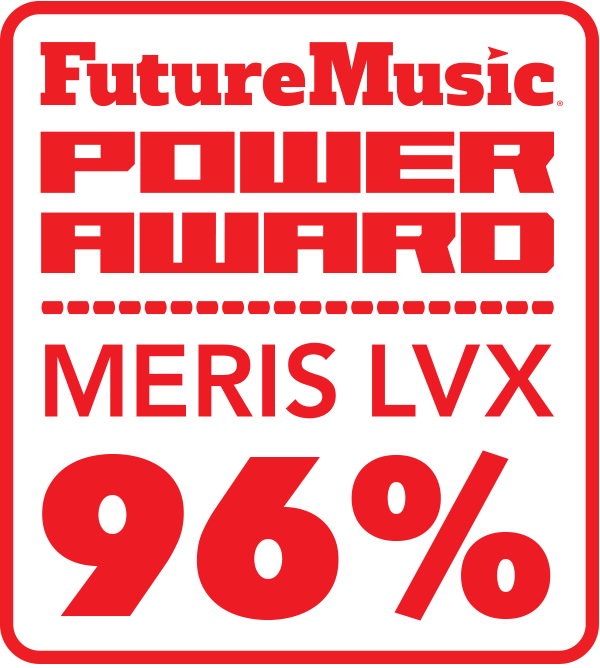
The Meris LVX modular delay guitar pedal costs $599.99 and is available now.
The Future: We’d love for Meris to develop a methodology for LVX users to simply share their own presets. We’d also like to see if Meris could utilize the USB-C port to interface the LVX with a DAW, which would open up a new market.
Interview: Terry Burton, Jinna Kim and Angelo Mazzocco
FutureMusic: Effects pedals are having a bit of a moment…
Terry: When we first started Meris, we concentrated on bringing our effects into the pro audio world but customers already knew our guitar pedal background. I’d like to think we had some influence early on in breaking guitar pedal effects out of their traditional form factor. That was already happening naturally of course, but mix engineers were regularly using pedals in the production process and that was part of the inspiration for our 500 series products. We are guitarists, but we also love synths and electronic music. Jinna and I have reached out to electronic musicians all the way back into the Strymon days just because that is music we listen to. With Meris, we threw out the whole notion that our pedals were just for guitar and I think it has proven very true. In addition to guitarists, there are synthesists, sax players, violinists, and vocalists all using our effects creatively. I love guitar, but the diversity of musicians using our stuff makes things so much more interesting.
Angelo: I think there are a lot of factors that go into the expanding role of guitar pedals. One part is the growing group of musicians using effects as instruments, as a true extension of their musical expression. Also I think that pedals are irresistible because they offer such an immediate and direct way of interacting and sculpting your sound. There is no substitute for turning knobs and dramatically altering your sonic landscape.
FutureMusic: Take us through the development process of a new guitar pedal or module at Meris. What’s the genesis of the idea? How does it go through the design process?
Terry: We consciously start with two criteria for a new piece of gear. One, it has a conceptual foundation that we may get from unorthodox sources like visual art or a film. Two, it needs to be an instrument in and of itself. Our qualification of it being an instrument is that it allows a musician to be creative in a way they couldn’t be without it. Enzo is an example of a pedal that is an instrument in the literal sense, where the signal being fed into it (usually guitar) becomes a controller to trigger actual oscillators, envelope generators, etc. Once we have the basic criteria for a new idea, it’s a collaborative process among our small design team to bring something to life. There aren’t any focus groups, marketing considerations or anything like that. The product is just driven by our collective passions and inspirations.
Angelo: Each project is a personal statement from us, and comes from a place of pure creation. I am always challenging myself to bring new sounds and new capabilities to the table, and it is all in service of expanding what’s possible for musicians. During development, a good sign that you are on the right path is when you get lost in the sound you are creating. If you find yourself getting drawn to play through what you are working on, it usually means other musicians will feel the same way.
FutureMusic: The LVX is a big leap forward in terms of complexity for Meris. What pushed you to develop and release a pedal with a visual interface?
Terry: One of the biggest leaps we made with LVX was graphical user interface development. We made a huge investment because the operating system is written from the ground up. Everything is custom. Jinna had a huge role in this product because she designed all of the graphics and much of how the UI flows from the user perspective.
Angelo: LVX is certainly a big technical leap, but in a lot of ways, I would say that LVX is the most accessible of all Meris pedals. From the easy access of presets, which give you a taste of what’s possible, to the Graphic View which Jinna carefully designed to help you discover the capabilities one component at time, to the Text View where the entire UI becomes a dynamic control surface, we focused on designing LVX to ease you through the journey of discovery.
FutureMusic: So, take us through the development of the LVX’s operating system including the dynamic GUI.
Terry: I had some initial sketches of designs and functionality for a larger pedal format including the idea that it should be a modular delay system. They were refined over the years by Angelo, Jinna and I working together collaboratively. The UI really came to life once Jinna started working on the final designs for LVX. She really took the lead on the UI design and made it beautiful and easy to use at the same time. It is extremely difficult to design something that is complex but also easy to use. Angelo went above and beyond what I could have envisioned for the modularity and signal flow of LVX. As always his DSP is just incredibly tasteful and excellent sounding as well. What I love about our team is that we’re all engineers and/or artists collaborating together. The development process is so much more fun when it’s done in that way.
Angelo: LVX’s operating system started out life as an extension of the code from our two footswitch pedals, and it has certainly grown exponentially from there. I’m so proud of what our small team has accomplished, everyone played such a deep role in bringing LVX to life. It is inspiring to work with such talented people, and I’m grateful for their deep drive to make LVX defy expectations.
Jinna: Professionally, I had made many GUIs in the past. But they were all fake UIs that didn’t need to work, they just needed to look cool. So LVX is actually my first real go on a working product. Honestly, I didn’t think I could do the product justice. I wanted the visuals to serve Terry and Angelo’s impeccable hardware and software well. I looked into hiring a UI/UX person, but Terry didn’t want to hire someone. He wanted only me to do it and encouraged me for weeks. I just used my own intuition. I strived for it to be intuitive and super easy to use. I didn’t want it to look cluttered and overwhelming.
I knew I wanted to incorporate the idea of star constellations and the natural occurrence of orbiting stars or planets. I didn’t want it so literal so I used bubbles instead. I developed the “Graphic View” which is more focused based; allowing the user to explore one parameter at a time through presets. I also pushed for “Text View” for those who want a more traditional style while simultaneously changing up to six parameters at a time. I think the biggest challenge was pushing animation within a smaller LCD screen. I was used to unlimited possibilities for TV – where the sky is the limit. There were limiting factors in pixels however, so I had to be very mindful of frame rate, how animation plays, how color looks, storage, processing power, etc.
Our software engineer, Jon Reeves is the fourth team member who worked on LVX from the ground up. Jon is brilliant, and I loved how he never compromised my vision. He always embraced my ideas. Building a user interface from the ground up is a lot of work. We worked side-by-side to make a carousel orbiting animation work. He pushed the code. And I pushed visuals. Our team really pushed hardware, software and visuals beyond our comfort zone to meet the challenge.
FutureMusic: Will the LVX now become a platform for Meris to expand into different types of effects beyond delay?
Angelo: We have so many ideas…
Terry: I don’t disclose future plans, but it certainly would be a waste not to use this powerhouse platform for more than one piece of gear.
FutureMusic: What inspires you these days?
Angelo: I am always inspired by watching people who are deeply in love with what they do. Before the lockdown, Terry and I visited Matt Brewster at 30th Street guitars and he clearly fits in that category. I love working on guitars, and have done almost every type of work you can think of, but I’ve always been afraid of fretwork. When I mentioned my fear to Matt, he pulled out a couple of guitars that needed different types of fretwork and generously proceeded in giving us a master class. I learned an incredible amount, and what stood out the most was how much he loved what he was doing.
Terry: It’s primarily music still but also visual art, movies…even comedy. We’re always sharing things with each other that inspire us and it’s very collaborative in that way. I’m grateful to have a team where we are friends too.
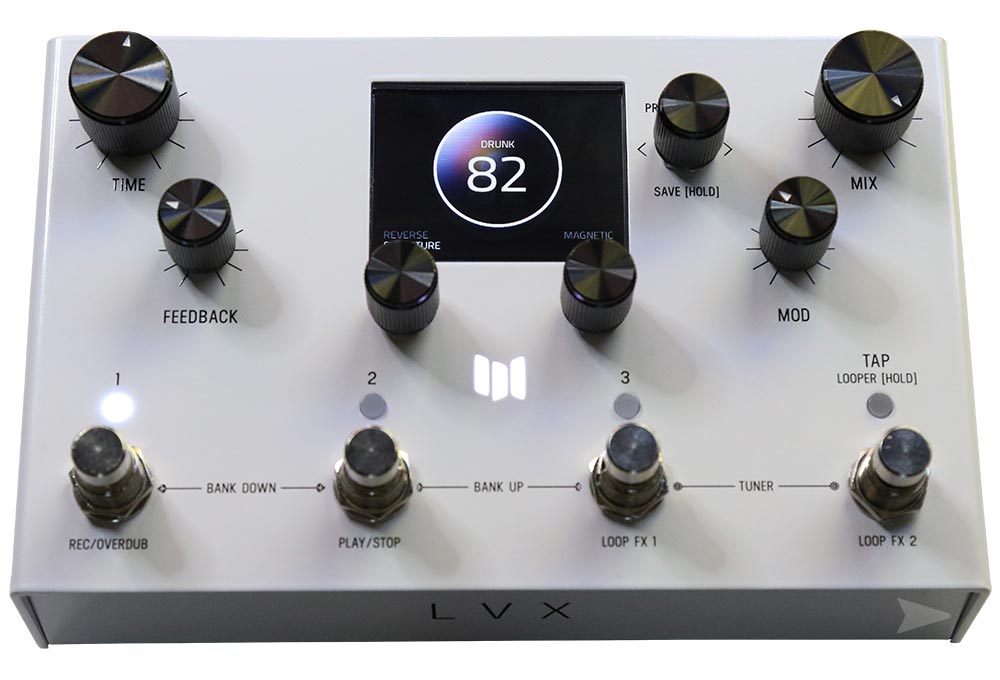
FutureMusic: Jinna, what are some of the unexpected ways that your unique skill set and background helped propel Meris?
Jinna: I love engaging, meeting, and/or connecting with people. I don’t know if that really propels Meris, but I truly do value relationships with artists, on-going customers and people in the industry.
FutureMusic: You’ve had an amazing journey from where you started to where you are today. What advice can you give to aspiring creatives from your unique perspective?
Jinna: When I was 18 and in community college, I took a printmaking class. I had a classmate who was an Eastern European exchange student. She was super cool looking; shaved head, punk rock, bad ass attitude. She was only an acquaintance. But she said, “Once you’re comfortable, you’ll never go anywhere.” I kept those words with me for the rest of my life.


